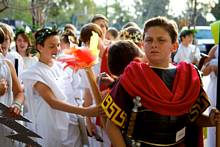-
WALK THROUGH ANCIENT WORLD – HISTORICAL ATTIRE

You don’t have to spend a ton of money to have fun dressing in historical attire for Walk through the Ancient World! Check in your own closet or your parents’. Craft, fabric and consignment shops have lots of great supplies that don’t cost a lot. Be sure to ask your parent’s permission when making your outfit.
Click on the civilizations below for directions on making ancient times historical attire.
See our Photo Gallery for examples of students dressed in attire from their ancient civilization.Egypt
Printable Instructions for Egypt
Ancient Egyptian clothing was mainly made of linen due to the hot climate of the region. Fabric was often draped and didn’t require much sewing.
Men wore kilts or tunics. A kilt was a knee-length piece of material wrapped around the waist and tied. Tunics are similar to a long t-shirt. Men wore capes of linen around their shoulders as well. They usually wore their hair short because of the hot weather.
Women of the Old Kingdom wore a simple sheath dress which was long, straight. It had one or two broad shoulder straps. Their hair was worn in simple styles, usually short. During the New Kingdom, clothing became more fancy. Heavy pleated, adorned robes were draped over the sheath dress. During this time, women wore their hair longer and sometimes decorated it with flowers, ribbon, and hair ornaments. Wealthier Egyptians wore wigs, sometimes scented with perfume.Egyptians often went barefoot, but also wore sandals. Both men and women wore jewelry. The wealthier wore items made from precious metals and gems. The common people had jewelry made of more inexpensive items like pottery beads or shells.
Greece
Printable Instructions for Greece
Greek clothing was typically made from linen or wool. Their main clothing was a tunic called a chiton. A cloak, called a himation, was draped across the shoulders, diagonally or behind both shoulders. Women’s clothing was floor-length. Men wore knee-length chitons. Women braided their hair and wrapped the braids around their head. Sometimes they added a headband made of ribbon, flowers or metal. Greeks often went barefoot or wore light shoes like sandals or slippers.
People think of Greeks wearing only white because of the white marble statues they’ve seen. Actually, their clothing was colorful and bright. Yellow, dark red, violet, green are just a few examples of the colors that Greeks wore. Clothing was sometimes embroidered with geometric designs such as the popular Greek Key.
ROME
Printable Instructions for Rome
The type of clothing worn in Ancient Rome depended on the person’s status. Clothing was more colorful, intricate and elaborate for upper-class members. The fabric was usually woolen cloth which was readily available. Later, silk was imported from China, but only the most wealthy could afford it. Roman men and women wore sandals or shoes that completely covered their feet.
Togas were the national garment of male Roman citizens. It was a large piece of material that was draped over and around the body. They were worn over a short-sleeved tunic which is similar to a long t-shirt. The colors of the clothing indicated the occasion or the social status of the male.
Women did not usually wear togas, but wore a tunic inspired by the Greek chiton. Two types of tunics women wore were the chiton and the peplos. Married women wore a stola, a long, sleeveless tunic, on top of her chiton or peplos. When women went outside they might wear a cloak called a palla that was draped over the left shoulder.
- Presentations
-
Teachers
CALIFORNIAAMERICAN REVOLUTIONANCIENT WORLDOTHER RESOURCES
- Students/Parents
- Reservations
- Photos
-
About
ABOUT CALIFORNIA WEEKLYIN THE PRESS
- Contact Us
- Presentations
- -- What is a Walk Through?
- -- Walk Through California
- -- Walk Through American Revolution
- -- Walk Through Ancient World
- Teachers
- -- CALIFORNIA
- ---- Overview
- ---- Class Activities
- ---- Preparation Tips
- ---- Costumes
- ---- State Standards
- ---- Photos
- ---- Walk Through California Teacher Preparation Guides
- -- AMERICAN REVOLUTION
- ---- Overview
- ---- Class Activities
- ---- Preparation Tips
- ---- Costumes
- ---- State Standards
- ---- Photos
- ---- Walk Through the American Revolution Teacher Preparation Guides
- -- ANCIENT WORLD
- ---- Overview
- ---- Class Activities
- ---- Preparation Tips
- ---- Costumes
- ---- State Standards
- ---- Photos
- ---- Walk Through the Ancient World Teacher Preparation Guides
- -- OTHER RESOURCES
- ---- Teachers FAQs
- ---- Useful Forms/Templates
- ---- Photo Gallery
- Students/Parents
- -- CALIFORNIA
- ---- Overview
- ---- Historical Attire
- ---- California Expert Card
- ---- More Information About California
- ---- California Rancho Information
- ---- Photos
- -- AMERICAN REVOLUTION
- ---- Overview
- ---- Historical Attire
- ---- American Revolution Student Cards
- ---- More Information About American History
- ---- Photos
- -- ANCIENT WORLD
- ---- Overview
- ---- Historical Attire
- ---- Ancient World Student Cards
- ---- More Information About Ancient World
- ---- Photos
- -- OTHER RESOURCES
- ---- Memorization And Acting Tips
- ---- Parent FAQs
- ---- Parent Helper Information
- Reservations
- -- Make a Reservation/Fill in Reservation Itinerary Details
- -- FAQs
- -- Pricing Information
- Photos
- -- California
- -- American Revolution
- -- Ancient World
- About
- -- ABOUT CALIFORNIA WEEKLY
- ---- History of California Weekly
- ---- Employment Opportunities
- ---- Our Presenters
- -- IN THE PRESS
- ---- Fan Mail
- ---- Reviews
- ---- In The News
- Contact Us

